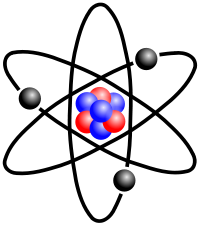Atomic mass

The atomic mass (ma) is the mass of an atom, most often expressed in unified atomic mass units.[1] The atomic mass may be considered to be the total mass of protons, neutrons and electrons in a single atom (when the atom is motionless). The atomic mass is sometimes incorrectly used as a synonym of relative atomic mass, average atomic mass and atomic weight; however, these differ subtly from the atomic mass. The atomic mass is defined as the mass of an atom, which can only be one isotope at a time and is not an abundance-weighted average. In the case of many elements that have one dominant isotope the actual numerical difference between the atomic mass of the most common isotope and the relative atomic mass or standard atomic weights can be very small such that it does not affect most bulk calculations but such an error can be critical when considering individual atoms. For elements with more than one common isotope the difference even to the most common atomic mass can be half a mass unit or more (e.g. chlorine). The atomic mass of an uncommon isotope can differ from the relative atomic mass or standard atomic weight by several mass units.
The relative atomic mass or relative isotopic mass (Ar) is the relative mass of the isotope, scaled with carbon-12 as exactly 12. No other isotopes have whole number masses due to the different mass of neutrons and protons, as well as loss/gain of mass to binding energy. However, since mass defect due to binding energy is minimal compared to the mass of a nucleon, rounding the atomic mass of an isotope tells you the total nucleon count. Neutron count can then be derived by subtracting the atomic number.
Relative atomic mass is also used as a synonym for atomic weight, the weighted mean of the atomic masses of all the atoms of a chemical element found in a particular sample, weighted by isotopic abundance.[2]
Contents |
Measurement of atomic masses
Direct comparison and measurement of the masses of atoms is achieved with mass spectrometry. The equation is, mass contribution = (% abundance) (mass)
Conversion factor between atomic mass units and grams
The standard scientific unit for dealing with atoms in macroscopic quantities is the mole (mol), which is defined arbitrarily as the amount of a substance with as many atoms or other units as there are in 12 grams of the carbon isotope C-12. The number of atoms in a mole is called Avogadro's number, the value of which is approximately 6.022 × 1023 mol-1. One mole of a substance always contains almost exactly the relative atomic mass or molar mass of that substance (which is the concept of molar mass), expressed in grams; however, this is almost never true for the atomic mass. For example, the standard atomic weight of iron is 55.847 g/mol, and therefore one mole of iron as commonly found on earth has a mass of 55.847 grams. The atomic mass of an 56Fe isotope is 55.935 u and one mole of 56Fe will in theory weigh 55.935g, but such amounts of pure 56Fe have never existed.
The formulaic conversion between atomic mass and SI mass in grams for a single atom is:
where  is the atomic mass unit and
is the atomic mass unit and  is Avogadro's number.
is Avogadro's number.
Relationship between atomic and molecular masses
Similar definitions apply to molecules. One can compute the molecular mass of a compound by adding the atomic masses of its constituent atoms (nuclides). One can compute the molar mass of a compound by adding the relative atomic masses of the elements given in the chemical formula. In both cases the multiplicity of the atoms (the number of times it occurs) must be taken into account, usually by multiplication of each unique mass by its multiplicity.
History
In the history of chemistry the first scientists to determine atomic weights were John Dalton between 1803 and 1805 and Jöns Jakob Berzelius between 1808 and 1826. Atomic weight was originally defined relative to that of the lightest element hydrogen taken as 1.00. In the 1860's Stanislao Cannizzaro refined atomic weights by applying Avogadro's law (notably at the Karlsruhe Congress of 1860). He formulated a law to determine atomic weights of elements: the different quantities of the same element contained in different molecules are all whole multiples of the atomic weight and determined atomic weights and molecular weights by comparing the vapor density of a collection of gases with molecules containing one or more of the chemical element in question [3].
In the early twentieth century, up until the 1960's chemists and physicists used two different atomic mass scales. The chemists used a scale such that the natural mixture of oxygen isotopes had an atomic mass 16, while the physicists assigned the same number 16 to the atomic mass of the most common oxygen isotope (containing eight protons and eight neutrons). However, because oxygen-17 and oxygen-18 are also present in natural oxygen this led to two different tables of atomic mass. The unified scale based on carbon-12, 12C, met the physicists' need to base the scale on a pure isotope, while being numerically close to the old chemists' scale.
See also
- Atomic number
- Atomic mass unit
- Isotope
- Molecular mass
- Jean Stas
References
- ↑ International Union of Pure and Applied Chemistry. "atomic mass". Compendium of Chemical Terminology Internet edition.
- ↑ International Union of Pure and Applied Chemistry. "relative atomic mass". Compendium of Chemical Terminology Internet edition.
- ↑ Williams, Andrew (2007). "Origin of the Formulas of Dihydrogen and Other Simple Molecules". J. Chem. Ed. 84: 1779.
